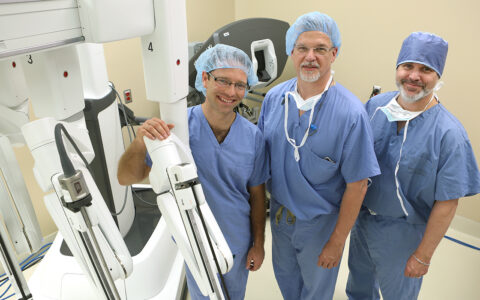The CEASAR study1 organized at Vanderbilt University Medical Center provided an unprecedented view of long-term outcomes for patients electing radiation therapy, surgery or observation for localized prostate cancer. Now, CEASAR data is being used to develop the first evidence-based online tool to guide recently diagnosed prostate cancer patients through a personalized treatment decision.
David Penson, M.D., chair of the Department of Urology at Vanderbilt and the project’s co-primary investigator, discussed his goals for developing the tool and research aims. The project is funded by the Patient-Centered Outcomes Research Institute (PCORI).
Discoveries: Before we talk about the tool you’re developing, would you explain the CEASAR study and how it will be used in this project?
Penson: In the original CEASAR study, we enrolled about 3,500 men from across the U.S. immediately after they were diagnosed with prostate cancer, but before they were treated. We used questionnaires to assess their quality of life and baseline function. After their treatment, we followed them at one, three and five years. The result was an incredible data set, now five years out, of men telling us about their outcomes and how they responded to therapy. This is not only if they are cancer free, but also their sexual function, urinary function, bowel function and quality of life.
Those data allow us to develop much more personalized estimates for a man diagnosed with prostate cancer. We can say, “For a man your age, race and baseline function, what is your individual risk?” It’s personalized medicine, but in a different sense because we’re using clinical characteristics to predict outcomes, rather than looking at genes. That leads into the shared decision-making tool—the new project. We’re incorporating those data into a web-based tool to help men make better-informed decisions about prostate cancer.
Discoveries: How will the tool work? What questions will be included?
Penson: Today, if you’re diagnosed with prostate cancer and talking to your doctor, you’re going to receive general information. If you choose surgery, the odds of you being cured are some number. Likewise, with your odds of erectile dysfunction or incontinence. In that type of shared decision-making, the information may not be presented in a way that really helps you work through your diagnosis and a treatment decision.
One of the great things about web-based tools is that they’re flexible, not static. The particular tool we’ll be using is online, and patients will fill it out when coming into the clinic. After a few preliminary questions, it guides them through things they need to consider—cancer control and cure, sexual function, time off of work, the risk of going back into the hospital, etc.
The tool will create a list of their preferences relative to one another. That’s the first piece. Next, patients can use their preferences to assess their odds for having different outcomes based on the CEASAR data. For example, if you’re a 45-year-old African American man in perfect health, your outcomes will be very different from a 75-year-old white man in poor health with poor sexual function. The tool then prints out a report for them to take to their doctor. This enables their doctor to have a more personalized discussion about options, through a process of shared decision-making.

Discoveries: What data are you planning to gather?
Penson: The research component will examine if men using the tool with their doctors have improved satisfaction. Will they be happier with their decision, and did it change their choice of treatment? My hope is that when men use this tool, they’re less likely to get regrets because they better understood the pros and cons.
If men in the study are satisfied, we want to make the tool publicly available. The ultimate goal is to refine a tool that is available for anyone online. We’re starting at Vanderbilt, but that is my hope.
Discoveries: In designing the questionnaire for the tool, what are the most significant variables you want to address?
Penson: We know from the CEASAR data that certain variables significantly affect outcomes. Treatment is one of the biggest, and we’ll also include specifics within treatments that affect outcomes, such as race, disease risk, PSA, how aggressive the cancer is, comorbidities, age, insurance status, baseline function and others.
In terms of what is shared back, the tool will provide patients’ risk with various treatments of having complications such as sexual dysfunction, urinary problems and bowel problems, alongside their chances of cancer control and cure. But all of this will be assessed in terms of their priorities. For some men, maintaining sexual function is worth potentially trading years of life, while others may not want a financial hardship.
Discoveries: Are you able to build the latest treatment options into the tool, based on the CEASAR data?
Penson: The original CEASAR study reflects treatments commonly used about seven years ago. Most have not changed significantly. In general, the CEASAR data are still highly relevant today.
For some new treatments on the horizon—focal therapy, for example—we don’t have much information within the CEASAR study. So, we can’t yet guide men in that regard. As most men with prostate cancer live many years, or decades, after diagnosis, we’ll need to wait on longer-term outcomes data on those new treatments.
Discoveries: An update to the CEASAR study has been funded. What will be the focus?
Penson: Dr. Daniel Barocas has taken the CEASAR baton and run with it. The focus will be a ten-year follow-up with the original cohort. Today, we catch prostate cancer earlier than we did 30 or 40 years ago. This update will help us understand what happens to men not just one, two or five years after diagnosis, but ten and twenty years later.
Many of these men will still be alive. We’ll be asking about their cancer recurrence, financial impact and how their disease has affected them. We’re also interested in how other diseases have interacted with their diagnosis of prostate cancer over time. When men make decisions, we don’t want them to make decisions for 10 percent of their remaining life. That’s not adequate to make a smart decision. It should be an incredible study offering one of the longest follow-ups to prostate cancer treatment yet. We’re excited.




